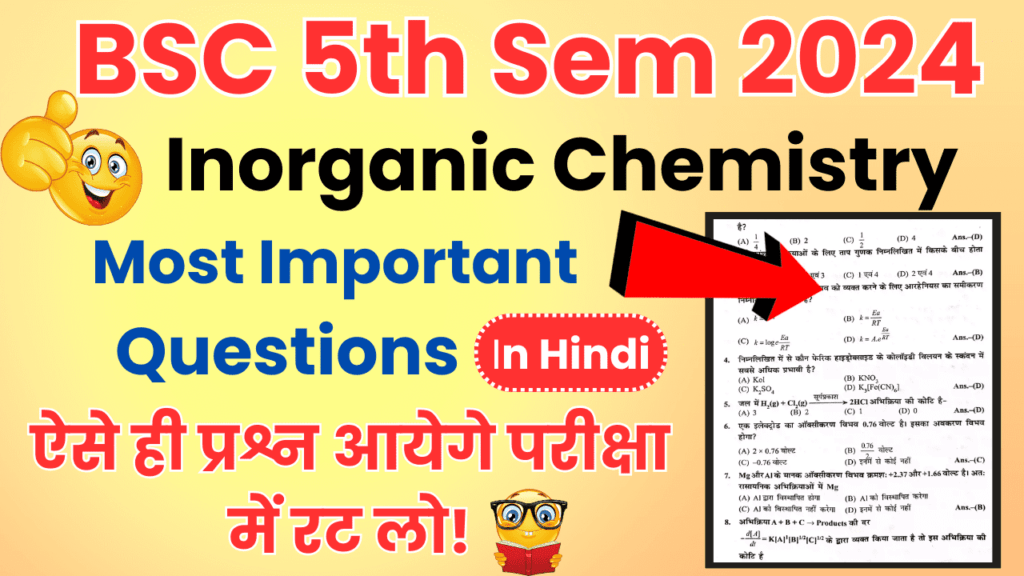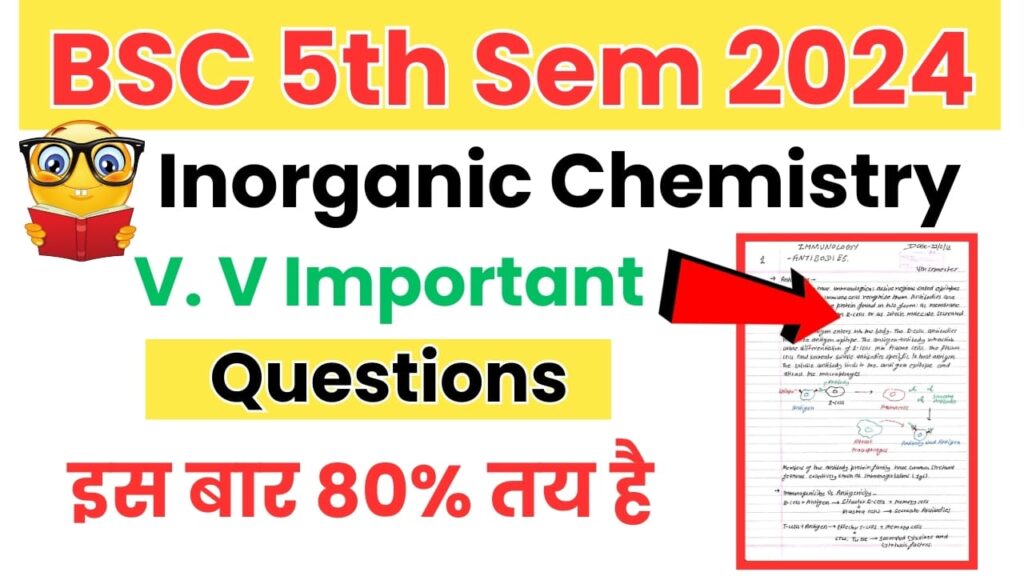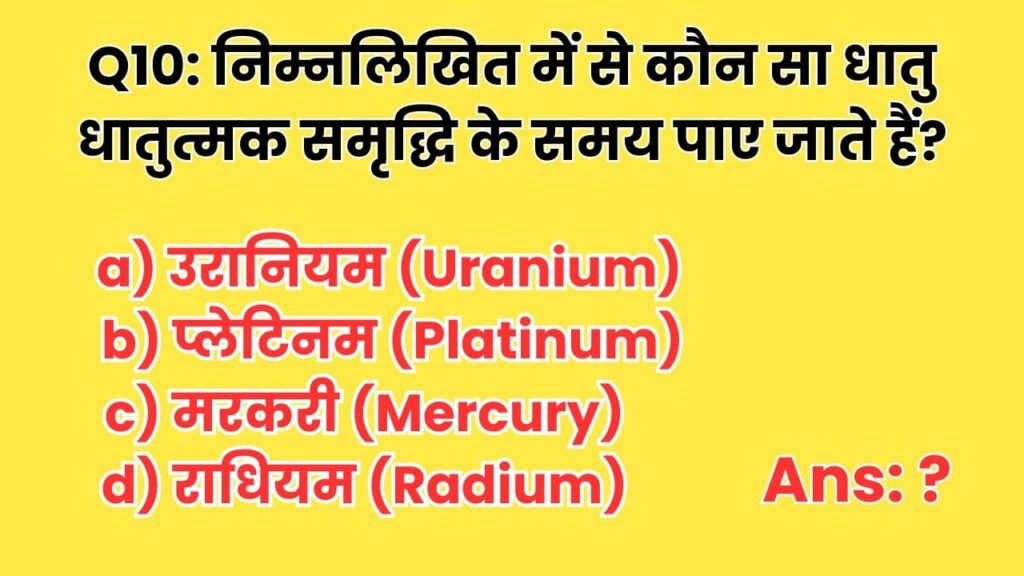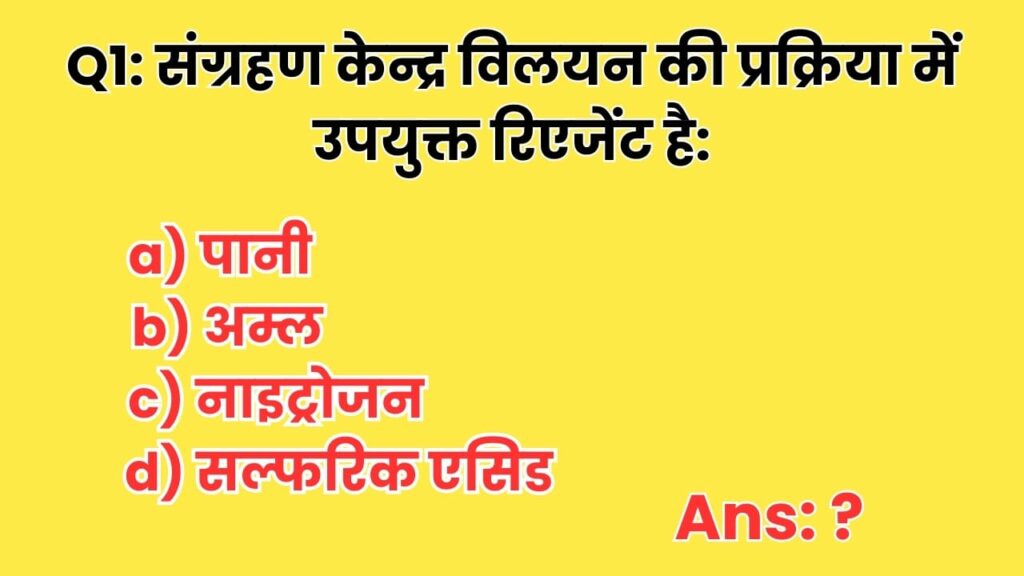नमस्कार साथियों क्या आप जानना चाहते है BSC 5th Semester Inorganic Chemistry Important Questions In Hindi 2024 के बारे में? दोस्तों आपका स्वागत है इस लेख में, हम आपको BSC 5th Semester Inorganic Chemistry Important Questions in Hindi के साथ BSC 5th Semester Inorganic Chemistry Syllabus और BSC 5th Semester Inorganic Chemistry Important Notes 2024 के बारे में भी बताएंगे।

जैसा कि आप जानते हैं Chemistry एक बहुत ही दिमाग लगाने वाला subject है, तो इस लेख में हमने BSC 5th Semester Inorganic Chemistry Important Questions In Hindi इकट्ठा किया है जो कि आपको पढ़ने में मदत करेंगे अगर आप इस लेख में बताए हुए Inorganic Chemistry Important Questions को एक बार रट लेंगे तो आप समझ लो 60% syllabus cover हो जाएगा, तो BSC 5th Semester Inorganic Chemistry Important Questions In Hindi 2024 की पूरी सूची पढ़ने के लिए इस लेख को अंत तक जरूर पढ़ें ।
BSC 5th Semester Inorganic Chemistry Important Questions In Hindi

Q1: परमाणु संरचना के आधार पर अपशिष्ट कोन समीकरण तरीके का निर्धारण किया गया है?
a) VSEPR सिद्धांत (VSEPR theory)
b) ह्यब्रीडीकरण (Hybridization)
c) MOT सिद्धांत (MOT theory)
d) आवात सिद्धांत (Valence bond theory)
Answer: आवात सिद्धांत (d) Valence bond theory
Q2: निम्नलिखित में सबसे अधिक इलेक्ट्रॉनिक ग्रहण क्षमता वाला अवकड़ कौन सा है?
a) ऑक्सीजन (Oxygen)
b) नाइट्रोजन (Nitrogen)
c) फ्लोरीन (Fluorine)
d) फोस्फोरस (Phosphorus)
Answer: फ्लोरीन (c) Fluorine
Q3: किस अणु के लिए ऑक्सीजन के समानांतर धरात्मक और ऋणात्मक ग्रहण संख्या होती है?
(A) बे
(B) b) सी
(C) सी (Si)
d) एस (S)
Answer: सी (c) Silicon
Q4: कौन सा आणविक अणु अपने आवेशित अवस्था में अधिक अस्थिर होता है?
a) s-ब्लॉक आणु (s-block element)
b) p-ब्लॉक आणु (p-block element)
c) d-ब्लॉक आणु (d-block element)
d) f-ब्लॉक आणु (f-block element)
Answer: d-ब्लॉक आणु (d-block element)
Q5: जिनमें से कौन सा आणविक अणु जल के साथ उदासीन है?
a) नायट्रोजन (Nitrogen)
b) कार्बन (Carbon)
c) सल्फर (Sulfur)
d) फ्लोरीन (Fluorine)
Answer: फ्लोरीन (d) Fluorine
Q6: निम्नलिखित में से कौन सा आणविक अणु एक ही प्रकार की जनरल बिजली नहीं देता है?
a) मैग्नीशियम (Magnesium)
b) बेरिलियम (Beryllium)
c) कैल्शियम (Calcium)
d) स्ट्रांटियम (Strontium)
Answer: बेरिलियम (b) Beryllium
Q7: किस तत्व का एक अधिक जीवनकाल वाला आवातिक सण्केतिक बनाया जाता है?
a) गोल्ड (Gold)
b) सिल्वर (Silver)
c) कॉपर (Copper)
d) प्लैटिनम (Platinum)
Answer: गोल्ड (a) Gold
Q8: निम्नलिखित में से कौन सा तत्व प्राकृतिक रूप से संगंधित नहीं है?
a) अल्यूमिनियम (Aluminum)
b) जिंक (Zinc)
c) टिन (Tin)
d) लेड (Lead)
Answer: लेड (d) Lead
Q9: कौन सा धातु उदासीन अद्भुत वर्ण का होता है?
a) जिंक (Zinc)
b) सिल्वर (Silver)
c) गोल्ड (Gold)
d) कॉपर (Copper)
Answer: सिल्वर (b) Silver
Q10: निम्नलिखित में से कौन सा धातु धातुत्मक समृद्धि के समय पाए जाते हैं?
a) उरानियम (Uranium)
b) प्लेटिनम (Platinum)
c) मरकरी (Mercury)
d) राधियम (Radium)
Answer: प्लेटिनम (b) Platinum

Q1: आधुनिक रसायन शास्त्र में सिलिकों की महत्वपूर्ण उपयोगिता क्या है? (What are the important applications of silicates in modern chemistry?)
Q2: कैसे प्रकार के अपद्मिक यौगिक होते हैं और उनकी विशेषताएँ क्या हैं? (What are the different types of non-aqueous solvents and what are their characteristics?)
Q3: धातुओं के बीच संयोजन के क्या कारक होते हैं? (What are the factors responsible for the formation of complexes between metals?)
Q4: धातुओं के बीच अद्यापिक उत्तेजन क्या है? (What is the mechanism of ligand substitution between metals?)
Q5: कार्बनिक यौगिकों के साथ संयोजन क्या है और इसका महत्व क्या है? (What is coordination with organic compounds and what is its significance?)
Q6: उत्तेजन की प्रक्रिया में कैसे धातुओं का समर्थन होता है? (How is metal supported in the process of activation?)

Q7: अपद्मिक यौगिकों के विभिन्न प्रकार क्या हैं? (What are the different types of non-aqueous compounds?)
Q8: रसायन विज्ञान में प्रायोगिक धातुओं के लिए उपयोगिता क्या है? (What is the utility of practical metals in chemistry?)
Q9: किस तरह से सिलिकेट संरचना में धातुओं का अध्ययन किया जाता है? (How are metals studied in the structure of silicates?)
Q10: क्लासिकल धातुओं का अध्ययन क्या है? (What is the study of classical metals?)
Q11: अम्लों के संयोजन के लिए मौलिक धातुओं का चयन कैसे किया जाता है? (How are basic metals chosen for the coordination of acids?)
Q12: परमाणु अंश के कारण एक धातु का एकीकरण कैसे होता है? (How does the integration of a metal occur due to atomic particles?)
Q13: धातुओं के बीच कम्प्लेक्स क्षेत्र की परिभाषा क्या है? (What is the definition of complex area between metals?)
Q14: अपद्मिक यौगिकों की अन्य प्रमुख सूचनाएँ क्या होती हैं? (What are some other major characteristics of non-aqueous compounds?)
Q15: आधुनिक रसायन शास्त्र में धातुओं के लिए उपयोगिता क्या है? (What is the utility of metals in modern chemistry?)
Q16: धातुओं के साथ अम्लों का संयोजन कैसे किया जाता है? (How are acids coordinated with metals?)
Q17: अपद्मिक यौगिकों के साथ आधुनिक रसायन में संयोजन का महत्व क्या है? (What is the significance of coordination with non-aqueous compounds in modern chemistry?)
Q18: रसायन विज्ञान में धातुओं का उपयोग किन-किन क्षेत्रों में होता है? (In which areas is the use of metals found in chemistry?)
Q19: सिलिकेट की संरचना में धातुओं के क्षेत्र की प्रमुखता क्या है? (What is the significance of the metal area in the structure of silicates?)
Q20: अम्लों के साथ धातुओं की प्रमुख विशेषता क्या है? (What are the major characteristics of metals with acids?)
Q21: अपद्मिक यौगिकों के लिए आधुनिक रसायन में संयोजन का महत्व क्या है? (What is the significance of coordination in modern chemistry for non-aqueous compounds?)
Q22: धातुओं के प्रायोगिक उपयोग क्या हैं? (What are the practical uses of metals?)
Q23: सिलिकेट में धातुओं के संरचना में क्या है? (What is the structure of metals in silicates?)
Q24: अपद्मिक यौगिकों के साथ संयोजन के प्रमुख लाभ क्या होते हैं? (What are the major benefits of coordination with non-aqueous compounds?)
Q25: धातुओं का प्रायोगिक उपयोग क्या है? (What is the practical use of metals?)
Q26: धातुओं के प्रायोगिक उपयोग में क्या हैं? (What are the practical uses of metals?)
Q27: सिलिकेट में धातुओं के संरचना में क्या है? (What is the structure of metals in silicates?)
Q28: अपद्मिक यौगिकों के साथ संयोजन के प्रमुख लाभ क्या होते हैं? (What are the major benefits of coordination with non-aqueous compounds?)
Q29: धातुओं का प्रायोगिक उपयोग क्या है? (What is the practical use of metals?)
Q30: धातुओं के प्रायोगिक उपयोग में क्या हैं? (What are the practical uses of metals?)
Also Read
- BSC 5th Semester Physical Chemistry Important Questions In Hindi 2024! इस बार यही आएगा, जल्द देखिए
- BSC 5th Semester Organic Chemistry Important Questions In Hindi 2024! इस बार यही आएगा, जल्द देखिए
- BSC 4th Semester Inorganic Chemistry Important Questions In Hindi 2024! इस बार यही आएगा, जल्द देखिए
- BSC 4th Semester Physical Chemistry Important Questions In Hindi 2024! इस बार यही आएगा, जल्द देखिए
हमें उम्मीद है कि इस लेख की मदद से आपको BSC 5th Semester Inorganic Chemistry Important Questions In Hindi 2024 के बारे में जानकारी मिल गई होगी।
दोस्तों आपको यह पोस्ट कैसी लगी कृपया हमें कमेंट सेक्शन में बताएं और यदि आपके कोई प्रश्न हों तो बेझिझक हमसे Comment Box में पूछ सकते हैं। यदि आपको यह पोस्ट उपयोगी लगी तो कृपया इसे दूसरों के साथ साझा करें।